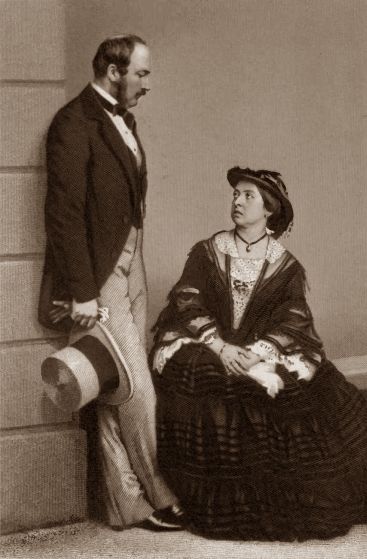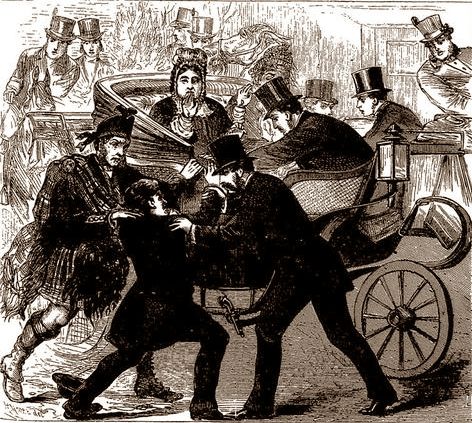Robert Francis Pate’s pate was addled. Just why
Robert Pate was so addle-pated we’ll never know but the poor man had problems
of his own which made him act in a befuddled manner. His father was a self-made
man who raised his own station in life high enough to be able to afford to buy
his son a commission in the British Army but, when stationed in Ireland,
Lieutenant Pate’s favourite horse and dog were both put down during a rabies
scare and it may be that the trauma of the loss was enough to tip Pate over the
brink and into helpless madness. He resigned his commission in the 10th
Hussars in 1846, and returned to London, where he lived an eccentric, reclusive
existence at Piccadilly and was frequently seen walking in the park dressed as
a dandy – even the Queen had seen this odd flaneur there.
 |
| Queen Victoria and child |
On May 27th
1850, as Victoria was leaving Cambridge House, after visiting her dying uncle,
the Duke of Cambridge, Pate approached her carriage and struck her on the head
with a short cane. Her bonnet absorbed much of the force of the blow but the
brass ferrule raised a considerable bruise and cut her forehead, leaving a
wound that was visible for many years afterwards. Pate was arrested and charged
under the 1842 Treason Act, found guilty and sentenced to seven years transportation
to Van Diemen’s Land. Claims that Pate was insane were rejected although he
seemed to have had no motive and Prince Albert wrote that the man was ‘manifestly
deranged’. Pate’s father pulled strings, hoping that his troubled son might
be better treated abroad rather than in an English gaol but things didn’t work
out as planned and Pate spent his first year serving hard labour at the
Cascades penal settlement. He was then moved to lighter duties, served his
sentence and lived in Hobart, where he married a wealthy heiress, until 1865
when the pair moved to London, where he lived quietly until his death thirty
years later.
 |
| Victoria doubts Albert's word |
The next attack came in 1872, when Victoria’s
circumstances were vastly different. Albert had died in 1861, the Queen blamed
Edward, their eldest son, for his untimely death and entered a period of deep,
deep mourning from which she never really emerged. She withdrew from public
life, became a virtual recluse, known as the ‘Widow of Windsor’, and wore black
for the rest of her life. Her partial re-emergence was helped by her
relationship with her Highland ghillie, John Brown, which raised a few eyebrows
but was probably quite innocent and was just a respectful, deep, Platonic
friendship. Still, on February 28th 1872, Arthur O’Connor, a
eighteen-year-old Irishman, climbed over the railings of Buckingham Palace and
approached the Queen with a pistol in one hand and a self-penned edict
demanding the release of Fenian Irishmen held in English prisons on political
charges. It appears that he sought to frighten the Queen into signing the edict
but when he raised the pistol, John Brown seized him and wrestled him to the
floor.
 |
| John Brown to the rescue |
The gun was broken and had no shot in it but nevertheless O’Connor was
found guilty of seeking to ‘alarm the Queen’ and sentenced to one year’s
imprisonment and twenty strokes of the birch. After a little negotiating, this
was changed to a self-imposed exile in Australia, where O’Connor lived under
the name of George Morton. He returned to London, was sentenced to an insane
asylum, went back to Australia, was committed to another asylum, escaped, was
re-committed and spent a further forty-four years shuttling around the
mad-houses of Sydney. He also wrote a letter to Queen Victoria, which was
intercepted before it reached her, offering to take the position of Poet
Laureate if only she would sack Alfred, Lord Tennyson, who currently held the
position. The cause of his madness was those great Victorian cover-alls – ‘debased
habits’ and ‘solitary vices’.
 |
| O'Connor fires at the Queen |
The final attempt on the life of the
Queen also involved a crazed Irishman, one Roderick MacLean, who fired at her
as she walked between a railway train and her carriage at Windsor Railway
Station on March 2nd 1882. A schoolboy from Eton struck MacLean’s
arm with his umbrella before he could aim the pistol, which was, for a change,
actually loaded and in working order, and the shot went wide. MacLean was
immediately arrested and charged with High Treason, but it quickly became
apparent that he was insane. Born into a good family, Roderick MacLean had
dropped out of society and lived as a virtual tramp, depending on handouts from
his family and the public. He had a fixation with the colour blue and the
number four, had sold a scarf and an old concertina and used the proceeds to buy
a pistol in Portsmouth, which he loaded with four bullets, and had then walked
from Portsmouth to Windsor. He had given one of the Queen’s ladies-in-waiting a
poem he had written for her Majesty but received what he regarded to be a ‘curt’
reply and so decided that honour demanded that he shoot her.
 |
| MacLean on Trial |
Understandably,
the jury went for a verdict of ‘not guilty, but insane’, a
decision that infuriated Queen Victoria who demanded to know how anyone could
be not guilty, when she had seen him fire a shot at her, obviously making him
guilty. Constitutional advisors tried to explain to the Queen that, under
English law, no man can be found guilty of a crime unless he be proved to have
had a criminal intention but Victoria remained unconvinced and pressed Gladstone,
her Prime Minister, for a change in the law, which occurred in 1883, allowing
for a verdict of ‘guilty, but insane’ a curious anomaly that remained on
the Statute Books until 1964. It is possible that she believed that if Edward Oxford had been hanged in 1840, this might have deterred all the subsequent
would-be assassins. Regardless, MacLean spent thirty-nine years incarcerated at
Broadmoor Criminal Insane Asylum, and died there from apoplexy in 1921.
 |
| Queen Victoria fights back |
This
final attempt, which may have been occasioned by a poem, certainly inspired
another poem by the great William Topaz McGonagall, Attempted Assassination
of the Queen, a magnificent piece that begins,
“God prosper long our noble Queen,And long may she reign!Maclean he tried to shoot her,But it was all in vain.”
And goes on to include the following lines,
“Maclean must be a madman,Which is obvious to be seen,Or else he wouldn’t have tried to shootOur most beloved Queen.”
Marvellous!
No comments:
Post a Comment